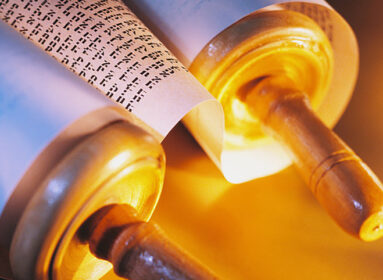
By Shlomo Riskin
“G-d spoke to Moses and Aaron, saying, ‘This is the ordinance (chukat) of the Torah which G-d has commanded, saying, ‘Speak unto the children of Israel, that they bring a completely red heifer, which has no blemish, and which has never had a yoke on it’ ” (Numbers 19:1-2).
Is it more important to devote oneself to personal, spiritual development or to work for the good of the nation? I believe that a good argument can be made that commitment to the nation takes priority over commitment to one’s own spiritual needs. And one such source is a Midrash (Shmot Rabah, Chap. 2:80), which links two kinds of animal slaughterings (not by blood, but by a common word—chukat). The Midrash has in mind the paschal lamb sacrifice of Exodus and the paradoxical ritual of the red heifer, (purifying the defiled, but defiling all those involved in its preparation), discussed in this week’s portion, Chukat, and quoted above.
In regard to the paschal sacrifice, the same word, chukat, appears. “This is the ordinance (chukat) of the pesach, no stranger shall eat of it” (Exodus 12:43).
Any law in the Torah called ‘chok’ has no rational explanation. Essentially a ‘chok’ is different from those commandments which are universally understood as ‘rational natural laws,’ like prohibitions against stealing, killing, etc. Rational laws are the key to a society’s survival, but a ‘chok’ is geared to the Jewish nation, religious ritual and is often mysterious, and beyond reason.
When it comes to the ‘chukim’ of the paschal lamb and the red heifer, their interpretation by the Midrash, focuses on two distinct approaches to Jewish life and practice.
Interpreting the verse, “May my heart be wholehearted with your statutes (Chukim) in order that I not be ashamed” (Psalms 119:80), the Midrash explains that this refers to the ordinance (‘chok’) of the paschal sacrifice and the ordinance (‘chok’) of the red heifer. Concerning the first we read, ‘zot chukat hapesach,’ (Ex. 12:43), and concerning the second we read ‘zot chukat haTorah’ (Num. 19:2). Once on a track of linking the two statutes (choks), the Midrash ponders which of the two is the greater and more important ordinance?
The analysis takes on the form of an analogy. If two identical women go out walking, how do we know which of the two is greater? Explains the Midrash that if one of the women is accompanying the other, is following behind the other, the one who is in front is the greater figure. Paralleling the case of the identical women, the Midrash guides us back to the case of the identical ‘chukim’ and the original question. Which is greater, the paschal sacrifice or the red heifer? Obviously, it is the one which is accompanied by the other, the one which is leading the other; and although they appear to be similar in stature, the red heifer always accompanies the paschal lamb, following behind. Before we can eat from the paschal sacrifice we must first be purified, and it’s the red heifer which provides the means of ritual purity, which must be activated before we are enabled to participate in the paschal sacrifice.
Rabbi Joseph B. Soloveichik, of blessed memory, my rebbe and mentor, takes this Midrashic conception a step further. The red heifer enables a person to participate in ritual ceremony — those commandments which link the individual with God. Thus the red heifer represents individual, spiritual purity.
On the other hand, the paschal sacrifice represents the national commitment of the Jewish people. The commandment to bring the ‘pesach’ was given just when we emerged as a nation, struggling to escape the claw of slavery. When the Torah commands the Jewish people to bring the paschal sacrifice, it tells us, in the very same verse, that a non-Jew is forbidden to eat of it. Any male who does not carry the indelible mark of being a Jew, circumcision, cannot join in. The entire character of the paschal sacrifice demonstrates how it’s not for individuals, how it may not be eaten by an individual, but must rather be eaten within a familial and national context. And since every single Jew in the community of Israel was commanded to take part, this ritual united every Jew to his fellow Jew.
If the red heifer is about individual ritual and religious purity, and the paschal sacrifice is about national commitment, it becomes indubitably clear that when one’s own spiritual development comes into conflict with a national issue, then our national commitment must come first; the national commitment is the purpose for the spiritual cleansing.
The paschal sacrifice is the goal, the red heifer is the means. Indeed there is even a halacha which states that if the whole community is ritually impure, and if a red heifer can’t be found, the people are permitted nevertheless to participate in the paschal sacrifice, symbolizing to the nation that our national unity and wellbeing transcends individual purity.
Consequently we see how one’s own spiritual development is only a means to the communal experience of the nation. Klal Yisrael comes first.
If we look at prayer, we see how its observance in Jewish practice teaches us something unique about our priorities. More often than not, prayer is an occasion when an individual trembles before G-d, an individual beseeches, an individual hopes. But for Jews, prayer is closely linked to a public moment. Individual prayer is consigned to a lower spiritual potential than when a group of at least ten, a minyan, pray together and that minyan is representative and symbolic of the Jewish nation. And, indeed, even when we pray alone, our prayer is always in plural, for the entire nation: “heal us, O G-d, so that we may be healed; see our affliction; restore Jerusalem to us….”
Alone, many of the most important prayers cannot be said. This doesn’t mean that in Judaism an individual’s self-realization is always sacrificed for the greater good of the whole. Rather, a dialectic and a tension exists between being a we-oriented people or an I-oriented people. At times, one must zealously, and even selfishly, prepare oneself for ultimate greater service to the Jewish community by shutting out the needs of the world, but the overriding goal of the individual must be to contribute to the needs of the nation so that we may indeed be a kingdom of priest-teachers to perfect the world.
Rabbi Shlomo Riskin is Chancellor of Ohr Torah Stone and Chief Rabbi of Efrat, Israel.








 Southern New England Jewish Ledger
Southern New England Jewish Ledger









